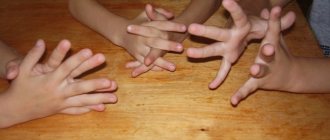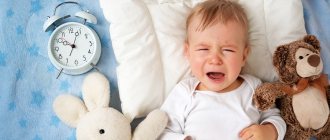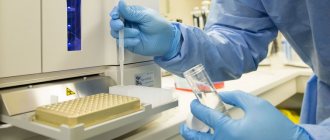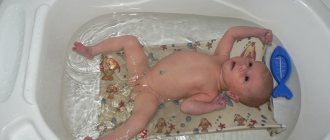Read in this article:
- Why is it important to blow your nose?
- How to blow your nose correctly?
- How to blow your baby's nose?
- Types and features of aspirators
- Play and learn to blow your nose
- A clean nose means a healthy baby
A runny nose is a fairly common occurrence in children of any age. A stuffy nose creates a lot of inconvenience and threatens with dangerous complications. The nasal passages need to be cleaned, i.e. blow your nose. But if this process is not a problem for an adult, then a small child does not yet know how to blow his nose, especially if we are talking about a baby. All mothers and fathers need to know how to teach a child to blow his nose and how to help a baby who cannot yet do this.
Why is it important to blow your nose?
The causes of a runny nose can vary from infection and colds to allergies. But such a sign always indicates problems with the nasopharynx. Normally, the air here is warmed or cooled to the desired temperature. In addition, the nasopharynx ensures that high-quality air enters the body and serves as a filter, trapping dust and harmful microorganisms on the mucous membrane. Snot is an accumulation of those same bacteria and contaminants retained by the “filter”.
When there are too many irritants, the nasopharynx begins to actively produce mucus. At the same time, the mucous membrane in the nose becomes inflamed, and all this leads to a feeling of stuffiness and difficulty breathing. Such symptoms are unpleasant for adults, not to mention children. A stuffy nose prevents the baby from sleeping and eating. And older children have a hard time if the parents haven’t figured out how to teach their child to blow his nose.
Despite the fact that a runny nose is a completely common and not very dangerous manifestation, it can lead to undesirable consequences. The accumulation of mucus inside the nasopharynx creates an excellent environment for bacteria to multiply, so you can’t dream of a quick recovery.
If a person does not blow his nose, mucus constantly flows down the back of the throat and provokes a cough because it irritates the nerves located there. Another nuisance is painful irritation of the skin under the nose.
How to blow your nose correctly?
To avoid all this, parents themselves need to know how to blow their nose correctly. To do this you need:
- Take a deep breath through your mouth;
- Press one nostril with your finger;
- Exhale through the free nostril;
- Repeat all these manipulations with the other nostril.
The exhalation should be sharp, but without excessive effort. If you blow your nose too hard, mucus can get into the maxillary sinuses and cause inflammation. Harmful bacteria can enter the middle ear and cause otitis media. There is also the possibility of damage to the Eustachian tube, which connects the middle ear and the back of the nose. The result can be ear congestion or barotrauma, nosebleeds, and sometimes a ruptured eardrum.
Such damage is especially likely if both nostrils close at once when blowing your nose, which leads to a significant increase in pressure. And this must be taken into account in order to understand how to teach a child to blow his nose without negative consequences for the body.
How to blow a newborn's nose
A buildup of mucus in your child's nose can cause persistent nasal discharge. This snot can block your airways, which can even become painful. In this case, we recommend blowing the baby’s nose with soft tissues: wipe the tip of the baby’s nose with them to remove accumulated mucus.
Always keep wipes handy in the Zewa Deluxe box. They will carefully remove accumulated mucus from the tip of the child's nose. Moreover, they are so durable that they can even withstand machine washing.
If your baby's nose is not breathing, you will have to treat it, but there are prevention methods that can be used every day to avoid nasal congestion.
You will need:
- cotton wool
- clean water at room temperature
- sea water
Roll cotton wool into flagella. Then wet them in plain water and “screw” them into the baby’s nose. After this, moisten the cotton wool with sea water and reinsert it into the nasal passages. Remember that there should be a different cotton swab for each nostril. You should not be afraid that you will somehow damage your baby’s nose, since the cotton wool is very soft, but you should be prepared for a violent protest on the part of the baby, since for him this procedure will not be very pleasant, although completely painless.
How to blow your baby's nose?
The baby needs to be taught how to blow his nose correctly. But what to do if a very young child gets sick? Most children do not immediately manage to master this difficult science, and no one is immune from diseases. Therefore, parents will have to blow their child’s nose for some time until he begins to cope with this procedure on his own.
Obviously, there is no way to teach a baby to blow his nose. He is still too small and not capable of such complex manipulations. To rid a small nose of snot:
- Soften the mucus by dripping saline into both nostrils - this will make it easier to remove snot;
- Use an aspirator to remove mucus;
- Wipe your baby's nose with a soft cloth;
- Repeat the procedure periodically as needed.
It's best to forget about classic fabric handkerchiefs. They accumulate microbes that, upon contact with the mucous membrane, penetrate the body. It is advisable to use disposable paper napkins. The nose should not be wiped, but blotted, to avoid irritation of the delicate baby skin.
The advice on how to blow the snot of a 1-year-old child looks roughly the same. It is unlikely that parents will be able to teach such a baby to blow his nose himself, so the aspirator will be used again.
How to help your baby with a bad runny nose?
As an advertisement
A nasal aspirator with a soft tip from ROXY-KIDS will easily clean your baby's nose!
An aspirator is a device that can be used to clear snot from a child’s nose. The device is especially relevant for infants who do not know how to blow their nose. Excessive mucus from the nose can enter the middle ear cavity and cause inflammation. To reduce the risk of its occurrence and the use of medications for a runny nose, there is such a device as an aspirator. It will remove nasal discharge without any problems.
How to use an aspirator correctly
A few minutes before the start of the procedure, you should drip a saline solution or a sea water preparation into both nostrils of the baby’s nose;
• It is advisable for the child to be in a vertical or semi-vertical position if the baby does not yet sit up on his own;
• In accordance with the instructions, suction the liquid first from one nostril, then from the other;
• After the procedure, be sure to rinse the device according to the instructions.
Types of nasal aspirators
There are 4 types of aspirators: syringes, mechanical, vacuum and electronic.
• Syringes are inexpensive and compact, but they will not save your baby from thick and abundant discharge, since the power of aspiration is limited by the volume of the bulb;
• Electronic aspirators are good helpers, but they are expensive. The batteries in such aspirators need to be changed regularly. And devices of this type, unfortunately, are short-lived.
• Vacuum aspirators suck out fluid from the nose in a matter of seconds, but they operate from a regular home vacuum cleaner. This means that this option is not suitable for travel. And, of course, many children are afraid of the noise of the vacuum cleaner, and because of this, this procedure;
• Mechanical aspirators are compact, affordable, and the suction power is controlled by the parent.
There are two types of mechanical aspirators: with consumables and without consumables. In the first option, in addition to the device itself, you will have to buy filters or disposable spouts. A device that at first seemed affordable may become anything but budget-friendly. The ROXY-KIDS aspirator belongs to the second group. Thanks to the patented design, the chamber through which the air flow flows and the chamber into which the mucus enters do not intersect, and this completely eliminates the entry of secretions into the tube. There is no need to purchase additional filters or change the spout, which not only makes the process easier, but also saves money.
Features of the ROXY-KIDS aspirator
• Two-chamber design;
• The tip is made of soft, high-quality German TPE, which does not injure the baby’s sensitive mucous membrane;
• The diameter and length of the tube are increased, thanks to which air passes easily and freely; • The reservoir where the liquid enters is transparent, which allows you to visually monitor the process of mucus discharge and record its color;
• All materials are absolutely safe and hypoallergenic;
• The aspirator tube and spout can be sterilized with boiling water (unlike PVC tubes, which cannot be exposed to high temperatures);
• A bright flower-shaped stopper distracts the child's attention and allows the mother to comfortably hold the mouthpiece in her mouth.
Why choose the ROXY-KIDS aspirator? By purchasing a ROXY-KIDS aspirator, parents will not only help their child clear mucus from their nose, but will also save money on the family budget. After all, now there is no need to buy additional filters or change tips, there is no need to use a vacuum cleaner or change batteries. The ROXY-KIDS aspirator is easy to clean and convenient to take with you on the road. The ROXY-KIDS company is pleased to present a new product that will benefit not only children, but also their parents.
Related product: [product](ROXY-KIDS NASAL ASPIRator 0+)
Types and features of aspirators
Such a device may have a different design, but the operating principle is always the same: drawing in air along with nasal mucus. While parents are teaching their child to blow his nose or are waiting for the right age for this, the aspirator will be an excellent helper. You just need to choose the appropriate option:
- Manual - pear-shaped syringe with a soft tip. The device must be squeezed, then carefully placed in the baby’s nose and gradually released. This method has several disadvantages. First, the syringe sucks out a small amount of surface mucus. Secondly, an opaque pear does not allow you to understand how much snot was collected and determine its color, and this is important for diagnosing the disease. Thirdly, cleaning such an aspirator is quite problematic. Fourthly, its use requires maximum care so as not to damage the nasal tissue;
- Mechanical - is a flask with a silicone nozzle, which is inserted into the spout, and a tube through which the parent draws in air through the mouth. The main disadvantage is the possibility of transmission of infection from a child to an adult;
- Electric – runs on batteries or a rechargeable battery, equipped with a baby-safe silicone tip and a transparent reservoir in which the result of the process is clearly visible.
Interestingly, many models of electric aspirators can be used not only to remove mucus, but also to rinse the nose. When choosing such a device, you need to pay attention to the noise level: if the device operates loudly, the child may be scared. It is best to use aspirators with silicone tips, which are easily disinfected and do not damage the skin. It’s even better if the aspirator can adjust the suction power.
Play and learn to blow your nose
But the use of aspirators does not replace the need to teach a child to blow his nose correctly. This is best done in a playful way using special exercises:
- Blowing out a candle - you need to light a candle and ask your child to blow it out. And then repeat the same thing, but with your mouth closed. The baby will automatically exhale through his nose;
- Snowstorm - the napkin is cut into small pieces, which the parent holds in the palm of his hand. The child’s task is to take a good breath through his mouth and blow away all the “snow” with his nose.” For this exercise, you can use balls of cotton wool or feathers;
- Blowing off foam - using the same principle, you can ask your baby to blow off foam while bathing;
- The whistle of a locomotive - the child imitates a locomotive that whistles with its pipe - its nose. You can use a toy train or show a cartoon on this topic.
For children, such games are interesting entertainment, and for parents they are a good way to teach a child to blow his nose on his own. Exercises should be repeated 1-2 times a day, changing them periodically. Gradually, the child will learn to breathe through the nose and blow air correctly, and treating a cold will take much less time. If your baby gets sick, you will need to ask him to repeat this game, but using a napkin.
How to blow your one-year-old baby's nose
When your child is a little older, show him how to blow his nose correctly. This will be one of the first steps towards teaching him to observe the rules of personal hygiene. Let the baby understand that blowing your nose correctly is pleasant. You shouldn’t force him to do this, just try to gradually develop these skills using different formats of exciting games.
- Hold the handkerchief to the child's nose and ask him to make a "dragon" sound with his nose.
- Place a cold mirror to the child’s nose and show what beautiful patterns can be created from the warm air that he exhales through a clean nose. Try it with one nostril first, keeping the other closed to make it easier for your baby to understand what's going on.
- Ask your child to blow out the candles on the birthday cake, exhaling only through the nose. Make sure that his skin and hair are at a safe distance from the flame.
Now you know how to blow your newborn's nose to prevent mucus from accumulating in your baby's nose. If, after all the described procedures, nasal congestion does not go away, then you should definitely consult a doctor - a pediatrician or a pediatric otolaryngologist.
Place a box of Zewa Deluxe wipes in the most accessible place for your child in the house. Let them always be at hand, and then the habit of how to properly blow your nose will quickly become established in your baby.
* According to the results of the Eurofins Evic study (Eurofins Evic), France, April 2021.
A clean nose means a healthy baby
There are several ways to teach children to blow their nose. The sooner a child learns to properly remove mucus from the nasal passages, the fewer health problems he will have. In the meantime, while the child is learning this important skill, parents should use a nasal aspirator to efficiently and safely clean the baby’s nose from the first days of the baby’s life.











